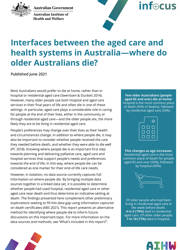Summary
Knowing where people die is an important first step towards planning and delivering palliative care, aged care and hospital services that support people’s needs and preferences towards the end of life. In this way, where people die can be considered as one marker for their end-of-life care needs.
However, in isolation, no data source currently captures full information on where people die. By bringing multiple data sources together in a linked data set, it is possible to determine whether people had used hospital, residential aged care or other aged care near death and thus determine an indicative setting at death. This report presents one method for identifying where people die to inform future discussions on this important topic.



